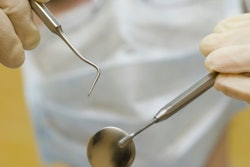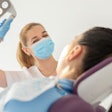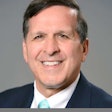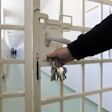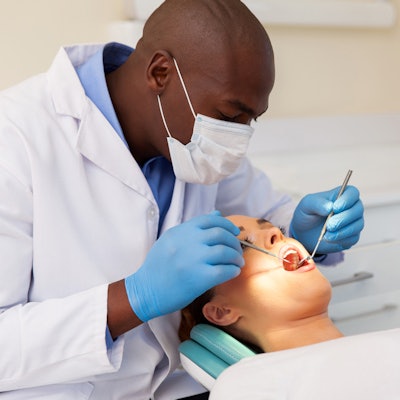
Since early 2022, dentists in the U.S. have been operating with schedules that are, on average, 86% full. Late appointment cancellations plus other factors are expected to keep things that way, according to data released on October 5 from the ADA's Health Policy Institute (HPI).
In September, patient no-shows and late cancellations remained the most common reason for unfilled practice schedules, but a lack of patients and staffing shortages also are playing a role, Brad Munson, HPI senior research analyst, said during the webinar.
"We are definitely in a holding pattern," Munson said.
Spending more, making less
During the past 12 months, most dentists reported increases in most expenses. Supplies and materials, staff wages, and lab fees have had the most substantial price increases.
Dentists reported that some expenses increased by more than 20%. Of those expenses, 31% of dentists reported paying 20% or more for personal protective equipment, about 26% reported paying 20% or more for supplies and materials, and about 16% reported paying 20% or more for staff wages. About 31% of dentists reported spending between 11% and 20% more on staff wages, according to the data.
Though dentists report spending more on wages, most are not catching up with inflation. HPI data released on October 3 showed that about 46% of dental hygienists and about 49% of assistants received pay raises in the past year. Of those who received raises, it was most commonly an increase in the 1% to 3% range. Since the inflation rate in the U.S. is about 8%, most are still making less.
"If you're raising wages 5% or 6% and the inflation rate is at 8% or 9%, that's a wage reduction," Marko Vujicic, PhD, chief economist and vice president for HPI, said. "... We hear lots of anecdotes that people are getting paid $60 per hour, $80 per hour, doubled wages. We hear lots of those stories, but the data are different. The data are showing a much more measured increase."
More on staffing
While the number of jobs in dental offices continues to rise, the average number of nondentist jobs per dentist is below pre-pandemic levels and is stable, Munson said. These jobs include hygienists, assistants, and office staff positions.
"This is further evidence of staff shortages but more importantly suggests we are in a 'new normal' in terms of the staffing mix," Munson said. "Staffing shortages are not going away any time soon. Practices need to adjust."
Insurance reimbursements
While expenses have increased, 57% of clinicians reported that the average level of reimbursement from all insurance companies stayed the same during the past 12 months. Additionally, 1 in 4 indicated that their insurance rates have decreased, and 11% reported not participating in insurance networks, according to HPI.
Dr. Krishna Aravamudhan, vice president of the ADA's Practice Institute, doesn't expect insurance companies to raise reimbursement rates to keep up with inflation.
"Sorry to be the bearer of bad news, but I think this is going to be financially challenging," Aravamudhan said. "From the insurance industry, they are well aware of the data but not seeing the market say, 'Let's raise rates.' At best, we're seeing localities where they announced a fee schedule that they now are holding and not putting those reduced fee schedules in place."
There have been 1% to 2% increases in reimbursements in small pockets of the U.S., as well as some insurance companies offering loyalty programs or incentives, she said.
"We're seeing it in small pockets, but nothing in aggregate," Aravamudhan said.
Wardah Inam, CEO of Overjet, added that she hasn't seen any major increases in reimbursements right now, but more in the industry are looking for ways to improve them.
"More people are engaging with consultants, etc., to actually negotiate these rates," Inam said.
What Aravamudhan said she is hearing the most is that more insurance payers are trying to lower their spending.
"Give me more electronics, EFTs (electronic fund transfers)," Aravamudhan said. "I don't want paper. Use my call center less. So they are definitely trying to reduce the spend on their side."
Dental spending
Using data from the U.S. Department of Commerce's Bureau of Economic Analysis, spending on dental services in August was estimated to be $113.4 billion at an inflation-adjusted, seasonally adjusted annualized rate. This represented a 0.7% increase from one month prior, a 6.4% increase from 12 months prior, and a 9% decrease from pre-pandemic levels, Munson said.
Also, healthcare and physician services have fared better than dental. Spending on healthcare services overall has recovered to pre-pandemic levels while spending on physician services has nearly recovered at 98% of pre-COVID-19 levels. Through August, U.S. dental spending had recovered to 91% of pre-pandemic levels.
Short- and long-term future
Those in the industry agree that dentistry's current state is challenging, but they don't see any significant risks coming within the next six months to a year. However, in the next few years, dentistry may change significantly due to anticipated continued staffing shortages, new technology, and potential policy changes.
In the short term, Inam expects things to stay the same.
"We don't see major risks six months out," she said. "Things may change in a few years."
For the next six months to a year, Aravamudhan doesn't anticipate any "big shift" and thinks that dentists will continue to adapt to staff changes. But the next five years are a different story.
In addition to watching the labor market and potential Medicaid and Medicare expansions, "we need to be keeping our eyes on AI (artificial intelligence), tech," she said. "Actuaries are going to have tons of data to manage risk differently, make individual plan designs, DSOs might be able to take up risk as consolidation grows. I'm watching the tech space. I'm watching the policy space. I'm watching the public sector."
Stephen Thorne, founder of the dental service organization (DSO) Pacific Dental Services, said dentistry is poised for growth.
"Oral health is health," Thorne said. "Oral health means better health. People are getting that, carriers get that ... I think the space is right for a massive bull market, but in the short term, it's going to be challenging."






